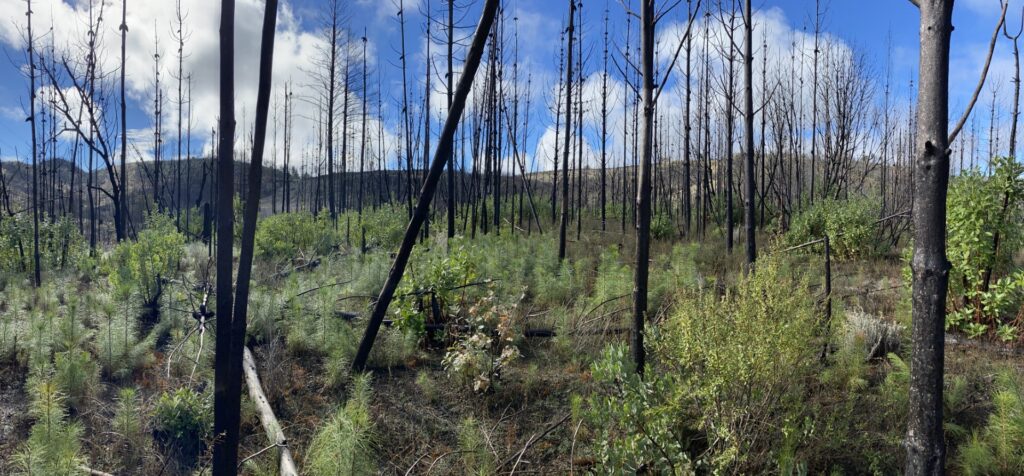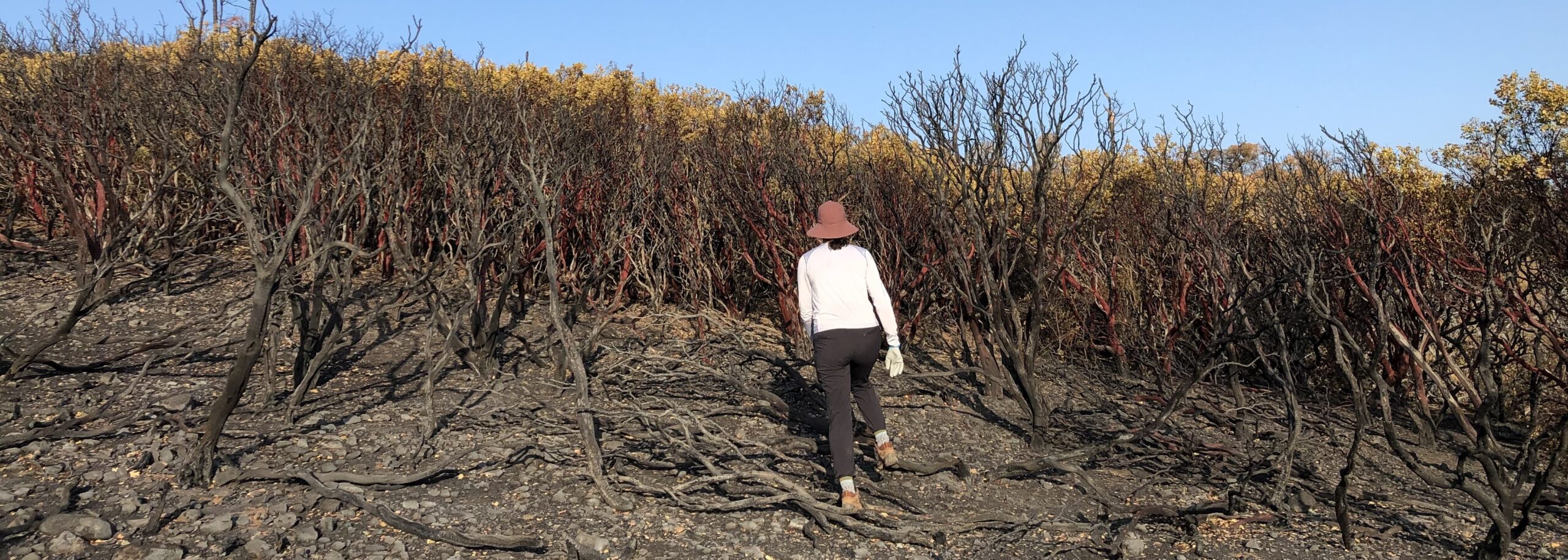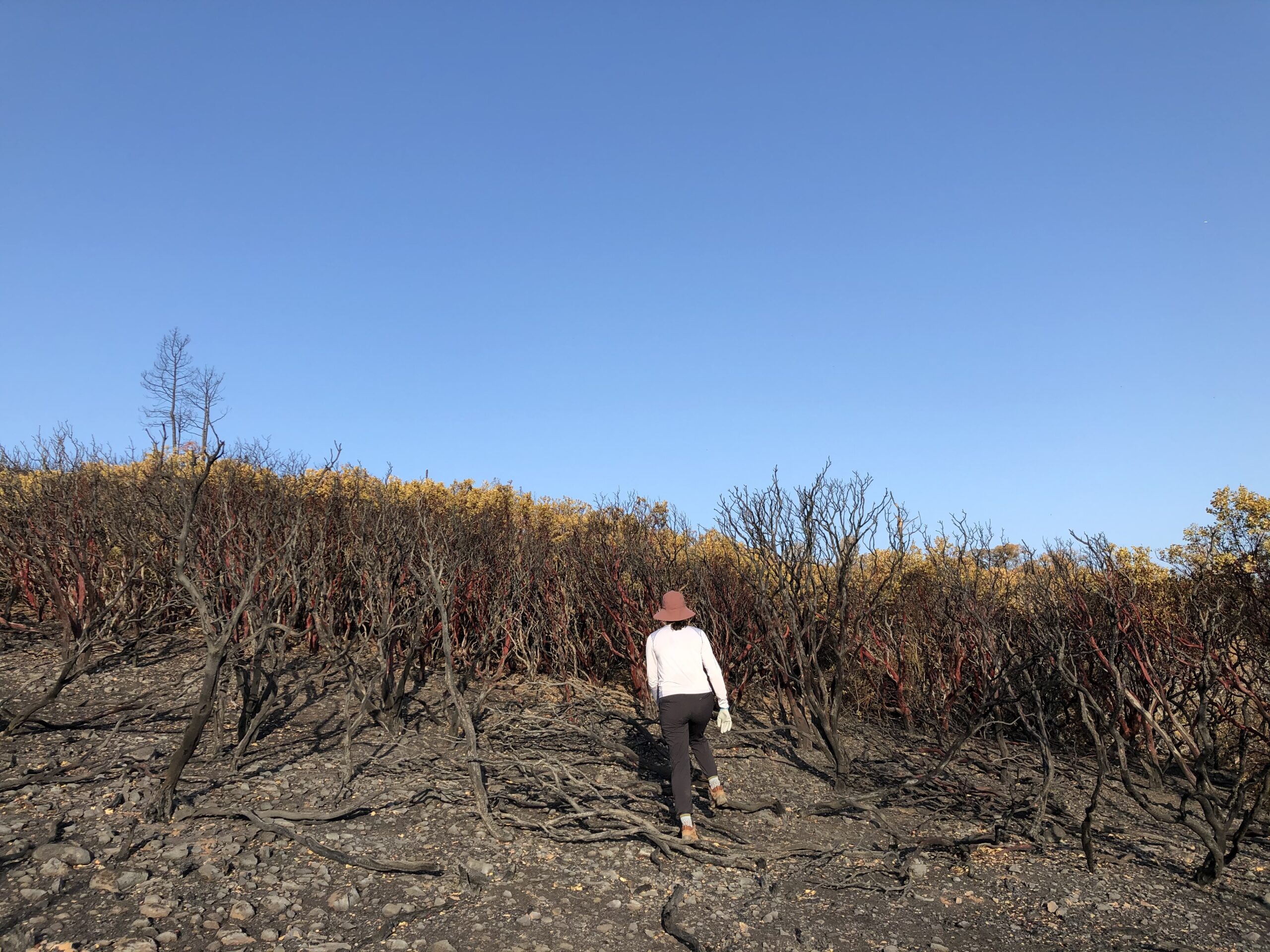Published: 12/12/2023
Planetary Health Postdoctoral Fellow Alandra Lopez investigates toxins in the environment that affect the health of people living or working nearby.
By Jamie Hansen, Global Health Communications Manager
Growing up in rural Massachusetts, Alandra Lopez, PhD, her family, and their neighbors relied on groundwater from private wells. In college, Lopez began to learn how toxins could be released naturally into such water from the surrounding environment, affecting residents’ health. This realization sparked a lasting interest in earth systems science.
Lopez didn’t expect that, years later, this interest would lead her to recently burned landscapes in the northern California mountains to sample the soil for toxins created when the wildfire’s extreme heat scorched mineral-rich soils.
And yet from groundwater to wildfires, a common goal has stitched together her career: a desire to use her science to make a difference in the health and wellbeing of communities. Lopez is now pursuing this work as a Stanford/LSHTM Planetary Health Postdoctoral Fellow.
“This fellowship is allowing me to engage with communities and create practical solutions to help minimize exposure to environmental health hazards,” she said.
Lopez recently earned her PhD at the Department of Earth System Science at Stanford where she worked alongside Scott Fendorf, Terry Huffington Professor in Earth System Science, exploring natural and man-made factors driving the release of harmful contaminants into the environment, including groundwater wells in California.
As a planetary health fellow, Lopez continues to work alongside Fendorf, now Senior Associate Dean of Integrative Initiatives at the Doerr School of Sustainability, and other Stanford experts from the Doerr School of Sustainability and the School of Medicine. Together, they’re investigating the prevalence and health impacts of harmful metals created when catastrophic wildfires burn through wildland areas rich with heavy metals, such as the Coast Ranges of Northern California.
Her interest in wildfires first evolved from her research on groundwater contamination. She became particularly interested in the element chromium, which occurs naturally in many northern California landscapes depending on geology and can sometimes end up in groundwater. For example, serpentinite, the state rock of California, is rich in heavy metals such as chromium. Usually, chromium remains in rocks and soil in a non-harmful state. However, some natural and man-made processes can transform the element to a harmful, carcinogenic form, called hexavalent chromium.

Lopez and Fendorf realized that intensely hot wildfires might cause such a transformation in certain geologic landscapes, presenting a risk for groundwater contamination.
Around this time, the 2019 Kincade Fire devastated Sonoma County, California in the Coast Ranges whose geology interested Lopez and Fendorf. They shifted their attention to research this, and once in the field, started to wonder how these fires affect air quality in addition to drinking water.
Lopez’s work felt mostly scientific at the beginning, as she hiked through recently burned natural areas and collected soil samples that could be tested for chromium and other hazardous metals. Over time, however, through working with local partners, firefighters, and medical experts at Stanford, Lopez was struck by the human, medical, and emotional aspects of the work. She saw communities consumed by recovery efforts and talked with wildland firefighters who were worried about their health and wanted to know more about what they were being exposed to.

“Increasing our understanding of what’s present in the wildland landscape became really important for me on multiple levels, both for firefighters and for communities returning near and within these burned areas,” she said.
Increasing our understanding of what’s present in the wildland landscape became really important for me on multiple levels, both for firefighters and for communities returning near and within these burned areas.
Alandra Lopez, PhD
Then, in 2020, the LNU Complex Fire burned through five counties including Sonoma and Napa, and Lopez returned to collect more samples. Her findings gave her work a new sense of urgency.
“Analyzing those samples, I started worrying about how I could protect myself. The magnitude of metals in these soils was far greater than those of the first fire I analyzed,” she recalled. “Sitting on the ground amongst all this dust and ash for hours really opened my eyes to what so many other occupations work with through much longer periods of time.”
In particular, they found dangerous levels of hexavalent chromium that remained in the soil for up to a year after the wildfire. This dust could threaten firefighters and residents who live near the burned areas, especially if the particles are easily distributed by wind.
Their findings were recently published in Nature Communications. Read more about the publication in this Stanford News story.
Still unknown is how much of the toxic metals end up in wildfire smoke, and how easily the particles can enter the body to cause harm. This is what Lopez plans to study next, in the second year of her fellowship. She and her colleagues are prepared with air quality monitors to characterize fire smoke, and Lopez is collaborating with other researchers at Stanford to understand how hexavalent chromium particles impact different parts of the body.
Lopez hopes their work will benefit communities impacted by wildfires around the world, not just in California.
Every continent except Antarctica has wildfire-prone landscapes with a geology that could result in this kind of toxic dust and ash, making this a global concern.
Alandra Lopez, Phd
“Every continent except Antarctica has wildfire-prone landscapes with a geology that could result in this kind of toxic dust and ash, making this a global concern,” Lopez said. “I hope that what we learn in California will provide really useful and translatable information to places around the world.”
Stanford’s Planetary Health Postdoctoral Fellowship is a collaboration between CIGH, the Stanford Woods Institute for the Environment, and the London School of Hygiene and Tropical Medicine. Learn more.
Lead photo credit: By Wilson Flower

